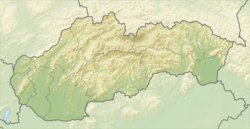Blatná na Ostrove
|
Blatná na Ostrove Sárosfa |
|
|---|---|
| village | |
| Location of the village | |
| Coordinates: 48°00′25″N 17°26′30″E / 48.00694°N 17.44167°ECoordinates: 48°00′25″N 17°26′30″E / 48.00694°N 17.44167°E | |
| Country |
|
| Region | Trnava |
| District | Dunajská Streda |
| First written mention | 1286 |
| Government | |
| • Mayor | Terézia Földváry |
| Area | |
| • Total | 10.77 km2 (4.16 sq mi) |
| Elevation | 121 m (397 ft) |
| Population (2001) | |
| • Total | 826 |
| • Estimate (2008) | 879 |
| • Density | 82/km2 (210/sq mi) |
| Ethnicity | |
| • Hungarians | 87,89% |
| • Slovakians | 10,17% |
| Time zone | EET (UTC+1) |
| • Summer (DST) | EEST (UTC+2) |
| Postal Code | 930 32 |
| Area code(s) | +421 31 |
| Website | www |
Blatná na Ostrove (Hungarian: Sárosfa, Hungarian pronunciation:[ˈʃaːroʃfɒ]) is a village and municipality in the Dunajská Streda District in the Trnava Region of south-west Slovakia. It has a post-office, a food store, a petrol station, and a bar. There is also a football playground and a public library in the village.
In the 9th century, the territory of Blatná na Ostrove became part of the Kingdom of Hungary. After the Austro-Hungarian army disintegrated in November 1918, Czechoslovak troops occupied the area, later acknowledged internationally by the Treaty of Trianon. Between 1938 and 1945 Blatná na Ostrove once more became part of Miklós Horthy's Hungary through the First Vienna Award. From 1945 until the Velvet Divorce, it was part of Czechoslovakia. Since then it has been part of Slovakia.
The records for genealogical research are available at the state archive "Statny Archiv in Bratislava, Slovakia"
...
Wikipedia

